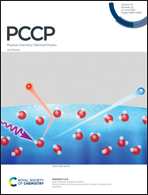Effect of Au/HfS3 interfacial interactions on properties of HfS3-based devices†
Abstract
X-ray photoemission spectroscopy (XPS) has been used to examine the interaction between Au and HfS3 at the Au/HfS3 interface. XPS measurements reveal dissociative chemisorption of O2, leading to the formation of an oxide of Hf at the surface of HfS3. This surface hafnium oxide, along with the weakly chemisorbed molecular species, such as O2 and H2O, are likely responsible for the observed p-type characteristics of HfS3 reported elsewhere. HfS3 devices exhibit n-type behaviour if measured in vacuum but turn p-type in air. Au thickness-dependent XPS measurements provide clear evidence of band bending as the S 2p and Hf 4f core-level peak binding energies for Au/HfS3 are found to be shifted to higher binding energies. This band bending implies formation of a Schottky-barrier at the Au/HfS3 interface, which explains the low measured charge carrier mobilities of HfS3-based devices. The transistor measurements presented herein also indicate the existence of a Schottky barrier, consistent with the XPS core-level binding energy shifts, and show that the bulk of HfS3 is n-type.



 Please wait while we load your content...
Please wait while we load your content...